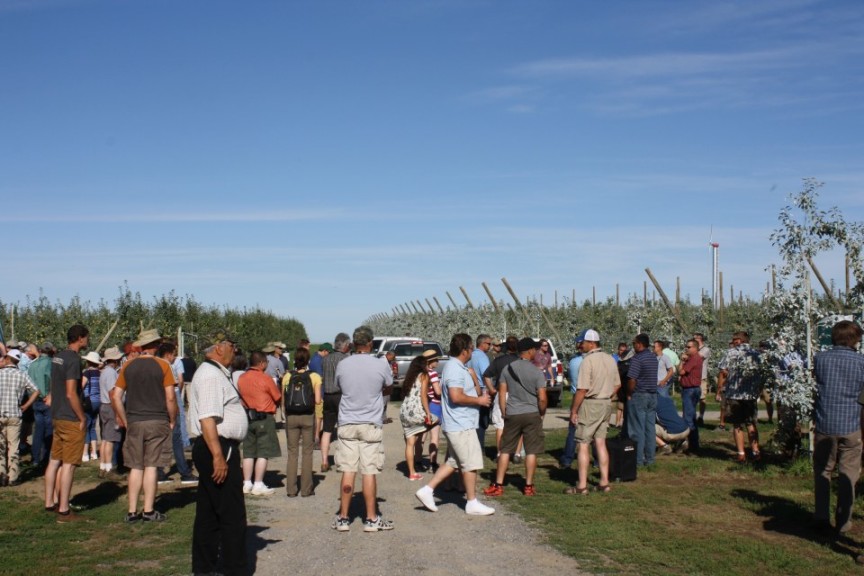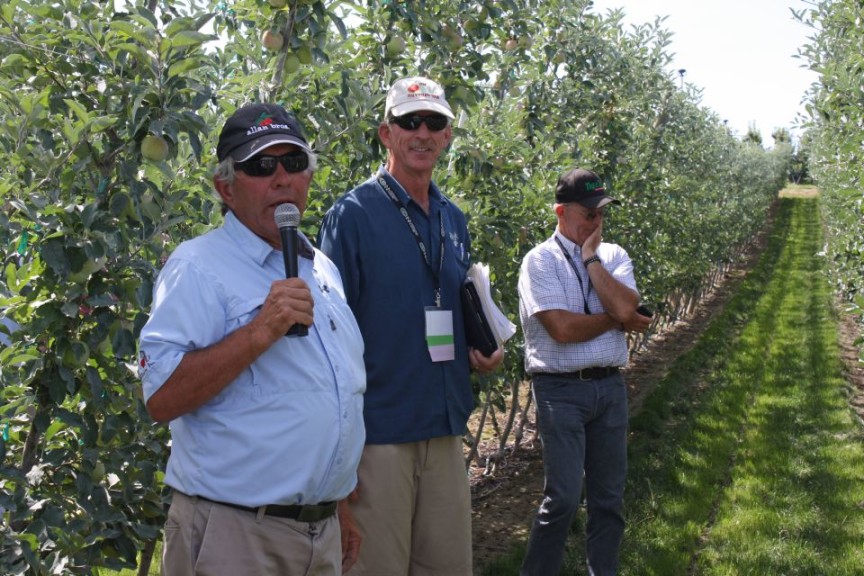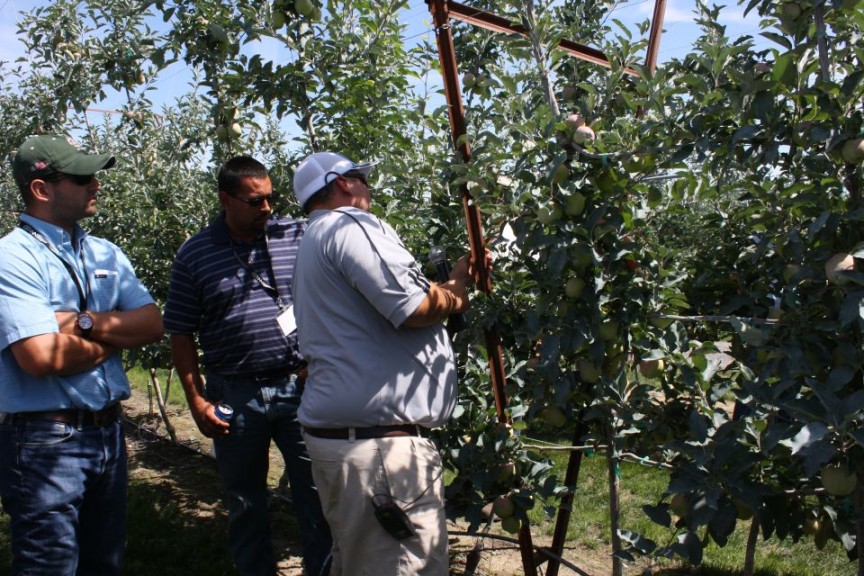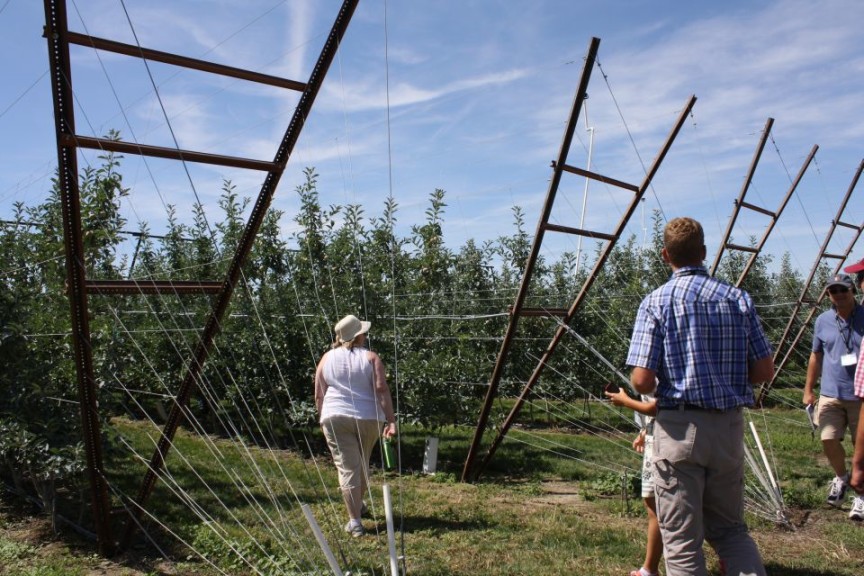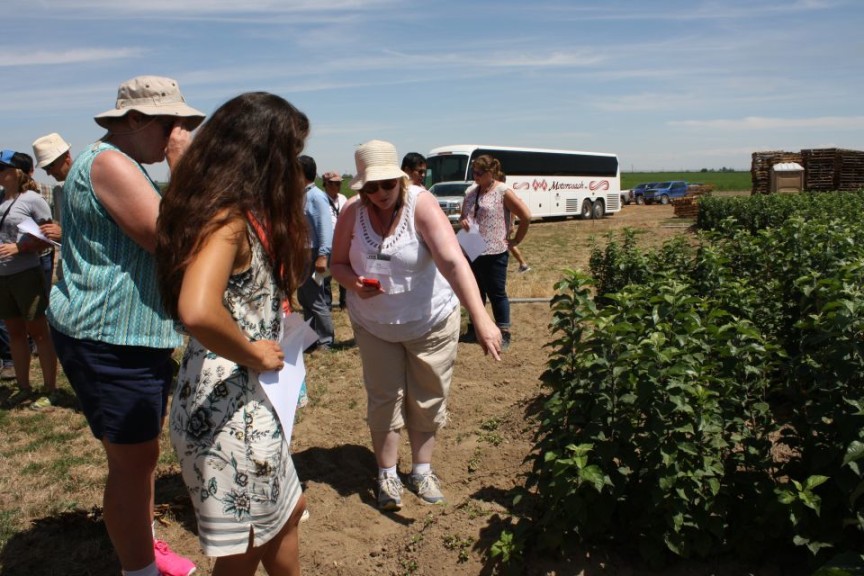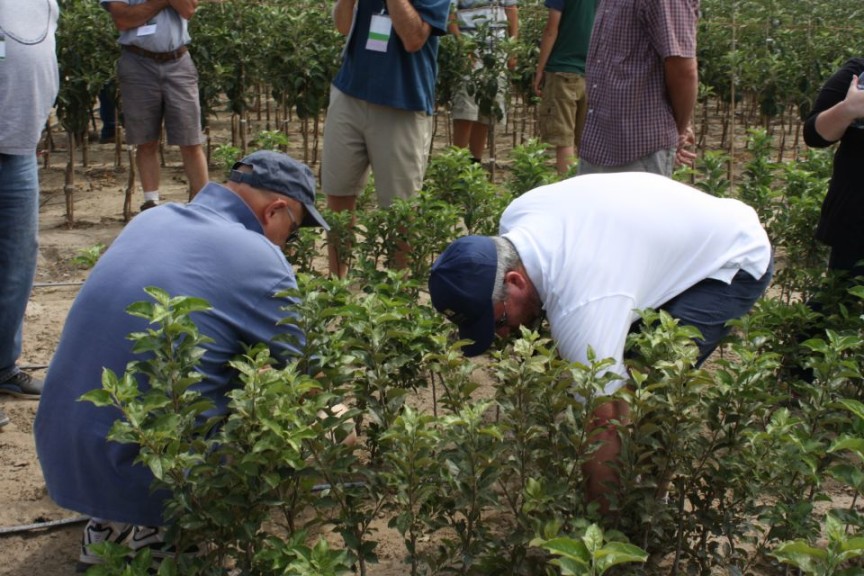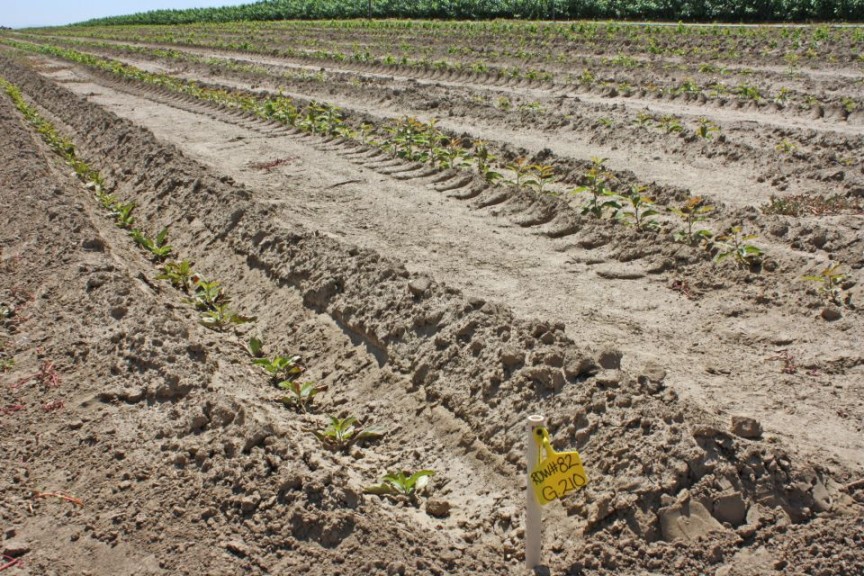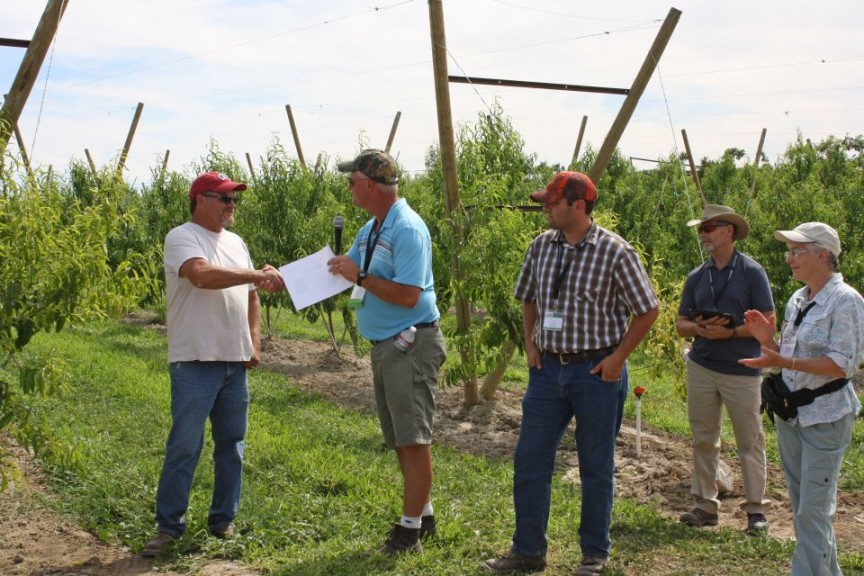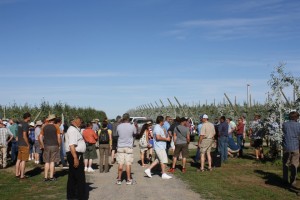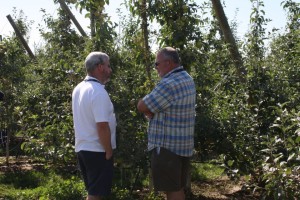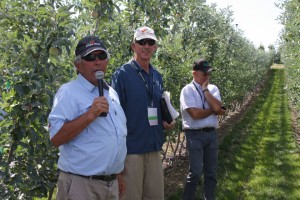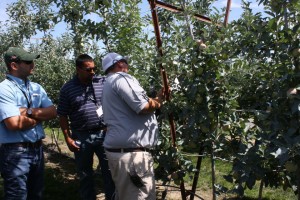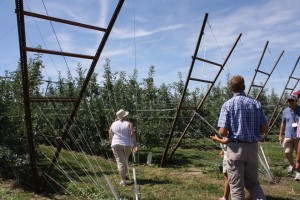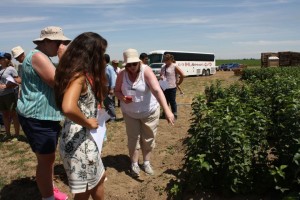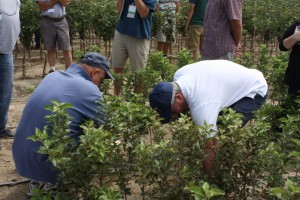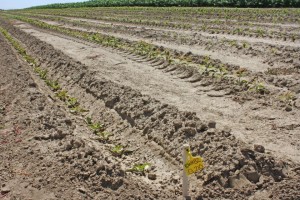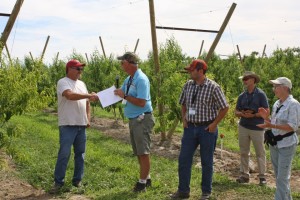Hot Temps, Hot Topics Served Up During IFTA Summer Tour
[blackoutgallery id=”76325″]
The first day of the International Fruit Tree Association (IFTA) summer tour in Washington State focused on the Pasco-area of Washington. Most of us were more than delighted that temperatures – which had soared into the low 100s for three weeks in a row – had now become a little more tolerable, reaching the into the low 90s, instead.
The theme of the first day was labor. Growers are experiencing quite a labor shortage, with the exception of Rick Orozco of Hi-Point Orchard.
While at the Mattawa West orchard for Stemilt, employees bemoaned the growing Washington winegrape industry was having on labor availability. As orchards become more labor-intensive, winegrapes, which can be harvested from the ground, become more appealing. Plus, less labor is coming across the border.
“Everyone is trying to find year-round labor,” Dale Goldy, assistant manager, says.
Plus, the cost to maintain these labor-intensive apple growing systems takes a cut into the bottom line.
Dave Allan of Yakima Valley Orchards says he sees a shift from the sky-high V systems to a pedestrian orchard may happen at some point. The loss of productivity on those pedestrian orchards seem like an initial detractor from shortening trees, however the improvement in efficiency may make up for it.
“Yield always trumps efficiency, however the most effective way to do something is if you have someone on the ground,” he says.
Pedestrian systems open itself up to more people to pull from for the labor.
Orozco says the whispers of a labor shortage are real. However, he hasn’t experienced it himself. With pears, cherries, peaches, apricots, nectarines, and apples in production, it’s safe to say there’s no shortage of work on the orchard.
The average employee at Hi-Point Orchard has been on the farm for 20 years. One employee has been there for 35 years. Orozco employs 60 full-time employees, and now has 75. He has built new worker housing and takes pride in keeping his employees happy and busy.
He says crews went 9 weeks without a day off. They had a few lately, and the consistency has been great.
“We don’t give them time to look for someplace else to work,” he says.
[blackoutgallery id=”76340″]
Day 2
The second day of tours took visitors to the Yakima Valley area of Washington.
Jason Matson was a busy guy when the IFTA summer tour visited his farm on Day 2. Matson Fruit Company was being Global GAP certified, his Sweetheart cherries were being picked for processing (since prices weren’t competitive for his cherries in the fresh market), oh and he had approximately 200 of his closest tree fruit friends on the farm.
Matson was asked how he deals with the Washington heat, although he did hint that they don’t have nearly the heat that Wenatchee has, his solution is “we pray.” Matson says his family is a senior water rights holder so that does offer some promise, but “you can’t get blood from a turnip.”
He’s considering putting shade cloth on his trees because under the shade cloth it will still run cooler. However, his orchards are not designed to implement shade cloth and he would need to retrofit his trellising. Anecdotally, he says one good thing about the overhead cooling is that birds don’t like the sprinklers.
Matson uses Extenday reflective ground cover to get color and light in the canopy. Especially in some of his very vegetative Honeycrisp blocks.
“We’re starting to wonder if we’re hitting the overdone point,” Matson says about Honeycrisp. “We’re trying to be very high yield in Honeycrisp. If things get ugly, the way to make things better is with volume per acre.”
Jim and Phil Doornink of Doornink Fruit Ranch also use Extenday to help get color and light into the canopies of their V trellis.
Bruce Allen of Chiawana Orchard, a pioneer in planting Honeycrisp in Washington, is known for his industry-leading production techniques. However, when it comes to bird control, Allen takes a very simple approach: granulated cane sugar. Although cane sugar is sweet when diluted, in pure form causes stomach discomfort and they stop eating the fruit. He applies 4 pounds per acre, every 7 days and it keeps the birds away.
On the opposite end of the spectrum, though, is Allen’s hail cannon, a shock wave generator believed to disrupt the formation of hailstones in the atmosphere. The cannon shoots up acetylene gas and air through lower parts of the cannon which become a shockwave. This shockwave travels to the cloud formation above the orchard and disrupts the formation of hailstones.
The device fires every four seconds prior to and until the storm passes. The precipitation falls as slush or rain instead.
Allen says the previous owner had a cannon and after several years of hail damage, three times in eight years under his ownership, he bought a device. His will cover 200 acres, he says.
“There’s been hail around us, and so far we’re clean,” he says.
Allen, too uses Extenday. He puts his out a couple of weeks after petal fall and keeps it out all season long to help with the biennial bearing nature of Honeycrisp.
“We can get the same premium color grade without Extenday,” he says. “But we get a much higher percentage of premium color at first pick, more uniform quality, and better consistency at the packinghouse.”
He puts Extenday on every other row so that his crews are able to drive down the rows without it to extend the use for two years (he alternates the row with Extenday year to year).
[blackoutgallery id=”76343″]
Day 3
If there was a theme of day three it was shade cloth. Growers in Washington have either purchased shade cloth, will purchase shade cloth, or are thinking of purchasing shade cloth. Washington State is in a state of emergency with little snowpack on the Cascades. This past winter, they got 38% snowpack, significantly less than what’s needed. So to say water is on the minds of growers is an understatement.
The last day’s tour took visitors around the Wenatchee area.
At Whispering Rocks Orchard, owned by McDougall and Sons, visitors got a first-hand look at mechanical hedging trials on Pink Lady on M.9-337 that Stefano Mustacchi of Washington State University is conducting.
“Cut down vegetation, increase light, and improve color,” Musacchi says of the goals of his research.
His project – in its second year — was successful in getting light into the canopy in 2014, so much so there was sunburn in the blocks with summer pruning.
This year, the orchard is covered in shade cloth. Although there were extreme loses last year, $2,700 per acre notes Brent Miline, a horticulturalist with McDougall and Sons. He estimates a 4-year payback for putting the cloth on, at a cost of $11,000 per acre per year, including the cost of labor. However, with no overhead cooling, it is a necessary commodity.
While on the way to Valley Fruit, we caught a glimpse of Avuil Fruit Company’s Vantage Ranch. The entire ranch, which follows the Columbia River, was covered in white – you guessed it – shade cloth.
Although Valley Fruit Company’s Royal 1 Orchard doesn’t have shade cloth yet, Scott Jacky says they plan to. And with 22-foot high trellising on a block of Buckeye Gala, he has every intention of putting shade cloth on.
However, Jacky says with the Food Safety Modernization Act, irrigation and food safety are a big concern. He’s also had a lot of hail damage, which is another motivation for covering the orchard. However, the only hang-up with using shade cloth instead of overhead cooling is the payback time it will take on a lower-value crop.
Valley Fruit also is sticking with 12 feet row spacing to allow for mechanization in the form of platforms.
Mechanization also is a big part of Winchester Orchards, where new plantings of Kiku, Kanzi, and Buckeye Gala are on tall spindle trees. As part of Washington State University trials, there are some trees on twin stems and the other block are on traditional tall spindle. The twin stems looked like a super spindle planting, just with half the trees and half the costs. But, his tall spindle trees out-produced the twin stems.
However, Tim Welsh of CMI and president of IFTA says the recipe for pruning of his twin stems is much easier for his crews to follow – prune out any wood that is too big.
Kanzi is a very precocious variety, Welsh says. It is favored in Europe because of its precocity. However, growing them have been a trial. All trees in the research blocks are bench grafts because of the unavailability of virus-free wood in Washington.
Welsh, is optimistic that Kanzi will be a big player in the market due to its explosive flavor and eye-catching displays and marketing.
Interesting note: The Royal Slope, and Washington as a whole has relatively inexpensive electricity. It is $0.02 per kilowatt and the Googles and eBays of the world use Washington to supply backup servers. To keep things in perspective, Sam DiMaria of British Columbia, Canada (and a previous IFTA conference tour host), said he pays $0.13 per kilowatt.





